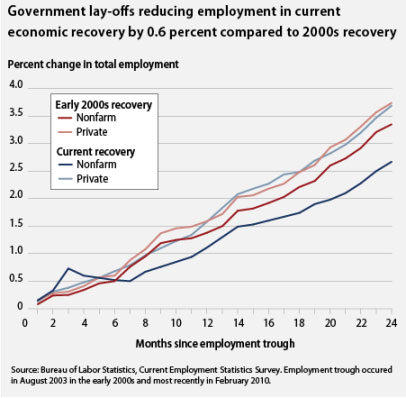The current economic recovery is going well if one looks at private sector job creation. The pace of private sector job creation is slower than in the recovery from the early 1990s recession, but it’s about the same as it was during the economic recovery in the early 2000s. In the first two years of both the current and early 2000s recovery, employment grew by 3.7 percent.
But since early 2009, governments at all levels have shed nearly 700,000 jobs, most of them at the state and local level. Since August of 2008 state and local governments have shed a total of 647,000 workers, of which 64 percent, or 416,000, were women workers.
When we compare total employment between the current and early 2000s recovery, the loss of public sector jobs pops out: Employment growth is 0.6 percent lower in this recovery than it would have been had government chosen not to hand out so many pink slips.

Last month there were 6,000 government layoffs, a much smaller number than in recent months, but still a drag on the recovery. And the crazy thing is that while policymakers cannot control the actions of private employers, they do control how much they add to the nation’s unemployment woes via government layoffs. Laying off teachers and police-officers as the nation struggles to get back to full employment is the wrong policy at the wrong time.
Our most important fundraising appeal of the year
December is the most critical time of year for Truthout, because our nonprofit news is funded almost entirely by individual donations from readers like you. So before you navigate away, we ask that you take just a second to support Truthout with a tax-deductible donation.
This year is a little different. We are up against a far-reaching, wide-scale attack on press freedom coming from the Trump administration. 2025 was a year of frightening censorship, news industry corporate consolidation, and worsening financial conditions for progressive nonprofits across the board.
We can only resist Trump’s agenda by cultivating a strong base of support. The right-wing mediasphere is funded comfortably by billionaire owners and venture capitalist philanthropists. At Truthout, we have you.
We’ve set an ambitious target for our year-end campaign — a goal of $119,000 to keep up our fight against authoritarianism in 2026. Please take a meaningful action in this fight: make a one-time or monthly donation to Truthout before December 31. If you have the means, please dig deep.